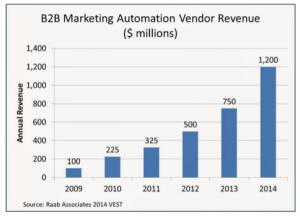The marketing automation space is growing rapidly and will continue to do so over the next couple of years, with marketing automation vendors predicting a 60 percent increase in revenue in 2014.
But are their revenues increasing quicker than your revenue when you implement the tools?
Moving to a marketing automation tool is painful and expensive. You will have to migrate data, get your staff trained, build your processes, set up integration with other software (e.g. CRM systems) and take on the substantial risk that, from the wide range of vendors to choose from, you’ve picked the wrong tool.
 So the reality is you start out by losing money.
So the reality is you start out by losing money.
And depending on the types of products or services you are selling you may still require a sales person to close off the deal so without the right team in place you can do all the nurturing you want but you may not get the sales.
What happens if you’ve picked the wrong vendor? Or if marketing automation is not suitable for your organization? Then it’s a lot of time and money wasted … which impacts your revenue.
But it’s not all bad news!
If your products/services are suitable for marketing automation, you spend the time picking the right tool and you invest the necessary time and resources up front, you can see significant returns, like Andy Mackensen’s H.U.M.A.N. Healthy Vending, who told me he’s seen amazing results:
“We increased revenue by 300% since implementing Infusionsoft.”
I’m studying marketing automation ROI with VentureBeat.
Help me out, and I’ll share the data with you.
That, of course, is music to the ears of marketing automation vendors, who are selling potential clients on the increases in revenue that marketing software will deliver:
“Typically our customers see a 20 to 50% increase in revenue after adopting marketing automation – some much higher than this,” Atri Chatterjee, CMO of Act-On says. “Our customers often get 6 times more traffic and 3.5 times more leads when they implement HubSpot,” Mike Volpe, CMO of HubSpot, echoes.
“We’re a managed service provider to large organisations. So we do a few big sales rather than lots of smaller sales. So while Act-On hasn’t made us money directly, it has helped us track interest from potential leads, make people aware of our offerings and get sign-ups for webinars we host”–
Matt Schroeder, MSS Solutions
But marketing automation is just a component of your overall inbound marketing solution, so these numbers are not simply due to marketing automation. So what does go wrong and how do you avoid this to ensure you get the returns the industry is quoting?
Decide whether marketing automation is suitable for your business
Marketing automation is not suitable to every business.
Does your team have the marketing skills necessary to take true advantage of it? Do you have sufficient leads that could feed into the marketing automation processes you’ll define? Do you have a good CRM tool to close all the leads you are nurturing? Do you have products or services that don’t require a lead nurturing process?
You need to ask these and many more questions before diving in and buying a silver bullet to all your marketing issues.
Pick the right vendor
Picking the right vendor to work with is not easy.
There are so many vendors to choose from with both the older more established players and the new kids on the block claiming to have the innovative features you require. To evaluate the players you’ll need to understand if this tool will fit in with the existing tools you already use, whether it have the flexibility to suit your workflows, and whether it will be too complex for your team to set up.
There are many considerations and it’s easy to get this one wrong. And it’s easy to under-estimate the work required:
“We dedicated one person full time to work on Marketo but it took us a lot longer to get our ROI because the software is complex and there was a lot of setup and planning required to build out the processes, such as drip campaigns,” David Henzel of MaxCDN told me.
Invest the necessary time upfront
There is significant work involved in moving to a new solution.
As Rick Carlson, co-founder of SharpSpring, said: “Marketing automation systems are not a time saver. You will invest more time but if implemented correctly you will get more results.”
A lot of vendors charge you an onboarding fee where you have a consultant assigned to you to help you build your marketing automation processes. As well as generating more revenue for the marketing automation provider it also helps with customer retention because they know that a lot of their customers will not figure out marketing automation themselves and will need help implementing it. To get maximum value from these calls you need to allocate the time and do your homework in between these sessions.
There’s no magic here: If you’re not prepared to invest the time, you won’t get the results.
Integrate with your existing tools and systems
The marketing automation tool you choose does not replace some of the existing tools or systems you have implemented.
For example, marketing automation providers typically have some form of CRM component in their solution. But they will generally not have the same level of functionality that the CRM vendors provide, so you will probably want to integrate with your existing CRM system.
These type of integrations are typically complex and some vendors may not even support your current CRM system. So it’s vital that you figure out how this is going to work or even if it’s going to work at all. Why nurture all those leads if it’s not fully integrated with your sales process?
Providing good integration options for some of your existing systems or tools will be a key requirement and this integration needs to be tested.
Iterate and test
Your marketing automation set up needs to be refined on a regular basis. Are you doing regular A/B testing? Are you analyzing the results? Are you tweaking to improve?
It’s the same with any digital marketing initiative, it never works perfectly and there’s always room for improvement.
The marketing automation space is hot and can do wonders for your business. But it’s not a magic solution, nor does it operate on its own. Moving to a marketing automation tool comes with a set of dangers but also the possibility of great results.
As with all software it has its pitfalls, but if you invest your money, time and resources wisely and pick the best solution for your needs, it will reap benefits.
What is your experience with marketing automation solutions? What were the key issues when you implemented a solution? I’d like to know.
Ian is the CEO of RazorSocial which has become one of the top social media sites globally since launching in just over a year with over 100,000 visitors per month and 7,000 subscribers.
VentureBeat's mission is to be a digital town square for technical decision-makers to gain knowledge about transformative enterprise technology and transact. Learn More


